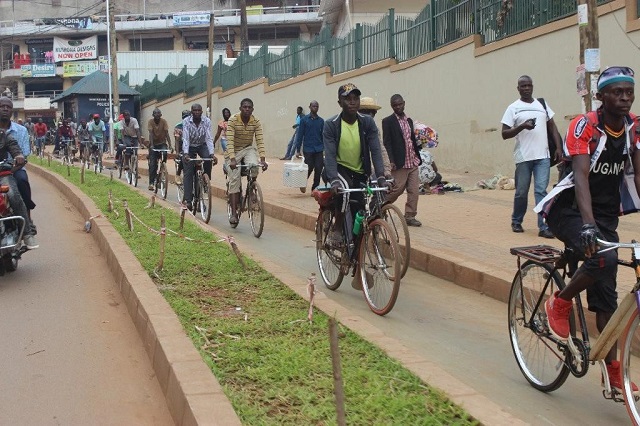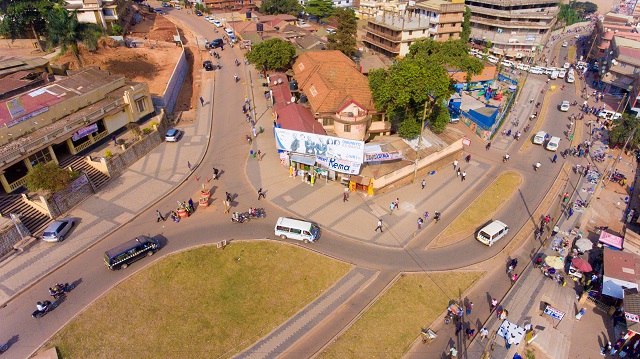
Cyclists in Kampala, Uganda, during COVID-19 lockdowns. Photo by Kikomeko Jackson
Cities in Africa are in something of a quandary when it comes to COVID-19. To date, the impact of the disease has been much less than most experts predicted. As of this writing, the continent has had over 890,000 confirmed cases and nearly 19,000 deaths. By comparison, the United States has had nearly five times the number of confirmed cases.
But the World Health Organization fears that COVID-19 infections in Africa are “accelerating” and countries will need strong proactive and preventive measures to slow the rise of cases. The African Centres for Disease Control and Prevention has highlighted that acting swiftly to address the spread of the virus in the transportation sector is imperative.
Meanwhile, government responses have been mixed. Almost all countries have introduced and supported strict physical distancing and hygiene standards. Countries like Algeria and Benin have suspended public transport entirely, but others like Ethiopia, Kenya, Cameroon and Guinea have focused on enforcing occupancy limits and reducing frequency of travel.
Even limited measures have not always been well received. While locking down any country has grave socioeconomic and safety consequences, it is even graver for African countries where the majority of the population depends on a daily income to survive. Irregular enforcement and limited coordination means regulations are often ignored. In Zimbabwe, a lack of capacity to screen people using public transport meant that for a period only doctors with private vehicles were reporting for duty. In Malawi, Uganda and Kenya, bus and minibus taxi operators increased fares after the government imposed passenger limits.
What can cities and national governments do to stop rising cases and ensure essential mobility services and livelihoods are not lost? The response to COVID-19 is a unique opportunity for African governments to promote walking and cycling not only as a quick fix but a strategic effort to build back better.
Targeted Investments Can Succeed
Many African cities lack the necessary physical environment to accommodate quick surges in cycling that have been seen in other cities. Poor urban planning has a major impact on the ability of significant populations to access basic services even during the best of times. There are few safe and accessible public spaces within walking distance for most residents, nor infrastructure for walking and cycling, like high-quality, connected networks of sidewalks, walking paths and cycling lanes. Despite the fact that more than half of travelers in African cities commute by foot – much higher than most other regions of the world – the private-vehicle-driving minority nevertheless rule the roads.
Investing in pedestrian and cycling infrastructure now, while the virus is more contained, can help cities be ready to accommodate more active mobility in the future.
Uganda is a case in point. In late March, during his fourth address to the nation, President Yoweri Museveni said that it was healthier to use a bicycle than public transport. During the COVID-19 lockdown, reduced traffic and increased political support led to a rise in the number of bicycle riders across the country, especially female riders, as well as a boom in business for bicycle dealers and mechanics.
During a recent symposium on urban mobility during COVID-19, Amanda Ngabirano, urban planner and lecturer at Makerere University, suggested that a major project along Namirembe Road-Luwum Street in Kampala and the country’s existing Walking and Cycling Policy (drafted in 2012) have both contributed to the country’s boom in cycling.
WRI and UNEP are among a growing coalition of organizations in Uganda that support the development of Kampala’s first non-motorized transport zone and other safe cycling and pedestrian infrastructure. The Non-Motorized Transport Pilot Corridor is a complete remodeling of a 2-kilometer stretch of road that cuts through the center of the city. The busy street is home to shopping malls, offices, theaters, is adjacent to a main transportation hub, the Old Taxi Park, and was until recently a main artery for car traffic.
The project is part of a wider strategy to decongest Kampala. The African Development Bank cited the Namirembe Road-Luwum Street project in its approval of support for a city-wide road rehabilitation project in May, showing how such efforts can be leveraged for further change. But the non-motorized mobility push has faced considerable challenges in funding and community support since the idea was first launched in 2011. Despite the fact that up to 90% of people in the area walk, there is growing evidence that retail sales increase with more walkable and bike-able streets, and the project involved intensive stakeholder engagement, the Kampala Capital City Authority had to reassure businesses that the corridor would be beneficial. Their concerns stemmed from the impact of prolonged construction on their trading, the lack of available parking in the area and the fact that the area is prone to flooding during rainy seasons.

Namirembe Road-Luwum Street project in Kampala is giving new priority to cyclists and pedestrians. Photo by KCCA
Non-motorized transport could also soon become a linchpin in the city’s efforts to improve air quality and road safety. City authorities have used the lockdown period to improve infrastructure, filling potholes, registering public transport vehicles and upgrading stormwater drainage. And during this time cycling has proven to be an efficient, affordable and convenient mobility option for residents.
But Kampala still has a long way to go to address its growing car-centric culture, and it remains to be seen how the changes will affect local traders who have already been severely impacted by lockdown restrictions since March 2020.
Changing the Paradigm
The Namirembe Road-Luwum Street project shows that active mobility projects in African cities can make a significant difference for pedestrians and cyclists, creating a safer environment for commuters during the pandemic. Governments throughout the region can learn from Uganda’s experience, and begin addressing mobility challenges in a way that promotes sustainable and safe mobility systems, both in the short term, adapting to COVID-19, and in the long term, working towards sustainable cities.
First, dedicated, high-quality walking and cycling infrastructure is indispensable. Active mobility projects already in the pipeline should be fast-tracked and all major urban corridors considered for traffic calming measures and reduced speed limits. Actively engaging with community groups to identify corridors with the most potential is essential. Community ownership ensures the long-term sustainability of interventions. In Kampala, an open letter to the president in response to government support for cycling during the pandemic showed high levels of both need and community engagement on the issue.
A second important short-term action is making bicycles affordable and accessible to as many people as possible. Introducing tax-free importation of bicycles and parts would improve accessibility and address the increasing demand and higher costs for spare parts. Partnering with local and international institutions can help sustain momentum. The Turkish government, for example, donated 100 bicycles to health care workers in Uganda after Museveni’s speech.
Lastly, although it is a challenge in many sprawling cities, planning to improve access to basic services is vital to the health of African cities and their commuters. The need to design cities so that core services are accessible for people who walk and bicycle is perhaps clearer now than ever, but it’s also needed to decongest cities and make public transport more accessible generally.
Policies and strategies that encourage resilient, inclusive and sustainable transport modes must be supported by investment in people-centric urban development. The development of walking and cycling policies together with “safe system” road design and transport management strategies and appropriate funding schemes are essential. Planned networks of cycling and walking also improve the livelihoods of those living and working in the informal sector and the most vulnerable in communities.
COVID-19 has revealed that sometimes it isn’t necessary to reinvent the wheel. Commitment to walking and cycling is not the most technologically advanced solution to the challenges many African cities face. But it is certainly among the most effective. Support for change now could blunt the accelerating spread of COVID-19, give cities more options to adapt in the future and help put African cities on track for a more equitable and sustainable future overall.
Iman Abubaker is a Health and Road Safety Project Coordinator for WRI Africa based in Addis Ababa.
Janene Tuniz is a Sustainable Mobility Project Coordinator based in Nairobi.
Anna Oursler is an Urban Mobility Project Coordinator for WRI Africa based in Kampala.





